How to extend the conventional life of your water tanks, bunds and cooling tower casings; avoiding temporary ‘fixes’ and costly replacements…
What is GRP?
Glass-reinforced plastics (GRP) a category of composite plastics that specifically use fibre materials to mechanically enhance the strength and elasticity of plastics. GRP is commonly used in the aerospace, automotive, marine, and construction industries and even found in ballistic armour…
GRP is a lightweight, extremely strong, and robust material making it incredibly versatile. It is less stiff and far less brittle than other composites such as carbon fibre. In addition, GRP’s bulk strength and weight properties are also very favourable when compared to traditional metal alternatives.
GRP is easily moulded into a wide variety of designs making it suitable for both standard and more bespoke applications including the lining of existing structures.
GRP has much to offer, with enduring quality that will complement most budgets. Serious and expensive problems can be solved efficiently, effectively and economically with GRP.
How Much Does GRP Lining Cost?
When considering your water tank, bund, or cooling tower refurbishment projects, GRP lining should be a serious contender. Where other coatings may provide a superficial ‘fix’ for a limited period, a GRP lining solution will give you peace of mind that you have extended the conventional working life of your plant for years to come.
It’s important however, to know when GRP is not a suitable solution. This really is only in the worst-case scenario where the underlying material has lost all integrity.
To fully understand the costs involved with GRP lining a free site survey should be carried out by an experienced technician. Call our technical team on 04103 892 622 to arrange a survey.
Is GRP Hazardous?
Glass Reinforced Polyester (GRP), commonly known as fibreglass is a polyester material combined with glass fibre.
Our GRP lining contractor is a responsible and committed Linings and Coatings Company. Their industrial containment options are safe to use in grey water systems using an eco-friendly lining that once cured will never emit chemicals.
There are GRP materials that can readily be used for potable water that have Water Research Council Certification, which satisfies Water Board Authority requirements. Such resins are to BS6920 and will not encourage Legionella Pneumophila growth. These resins have been subject to extensive microbiological growth tests.
How Do You Dispose of GRP?
We are often asked by our clients how GRP products can be disposed of in an environmentally responsible way. Historically, 100% of this waste stream would have gone as General Waste.
Companies such as Agecko have found an alternative, greener GRP recycling solution. Agecko UK Ltd work alongside Composites UK. Their aim is to educate and encourage companies to get involved with GRP recycling. The most common outlet for this waste stream would be Waste to Energy.
This process generates energy in the form of heat from the primary treatment of waste. The only remaining waste after the burn is the actual glass fibres. These fibres sit within the Incinerator Bottom Ash (ICA) and is collected. Ash is processed to make an aggregate suitable for construction projects and in the manufacture of asphalt.
Read more: https://www.agecko.com/services/waste-types/glass-reinforced-plastic-grp/
How Tough is GRP?
The material strength of GRP is achieved by mixing polyester resin and glass fibres. Once the surface has been prepared glass fibres are applied into the resin in layers to reinforce and increase structural integrity. This method can be used to create varying strengths and flexibility required.
A Cooling Tower GRP lining system provides:
- Corrosion and chemical resistance
- Totally seamless forming a ‘tank within a tank’
- Mechanical strength – fibreglass reinforcement built up in layers as required for added thickness
- Cold applied therefore no hot works required
- Existing surfaces easily prepared and repaired. Rust is treated to prevent any further oxidisation
- Suitable for all types of metals and plastics
- Legionella prevention – Ensuring cooling towers are kept free of legionella takes more than just water treatment. Corroded and scaled internal vessels are ideal conditions for bacterial growth and aerosol release.
In addition to GRP lining, Vistech Cooling Systems install GRP Cooling Towers and GRP Access Platforms.
What can be lined?
It may be easier to answer what can’t be. GRP is a remarkably adaptable and durable material that can be applied to many surfaces including..but not limited to:
- Mild Steel
- Stainless Steel
- Concrete
- Brick work
- GRP
Typical applications include the lining of:
- Sectional Steel or Braithwaite Water Tanks
- Cooling Towers and Evaporative Condensers
- Chemical Bunds
- Sewerage Tanks
- Drainage Channels
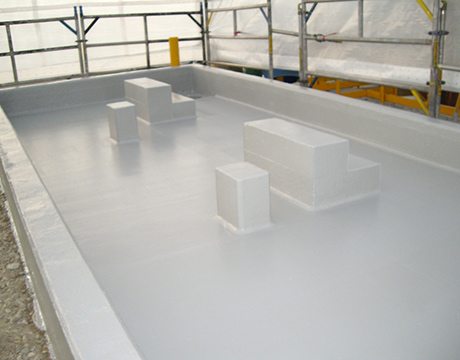
Above – chemical bund lining
Why use GRP lining as a coating?
As we’ve already discussed, GRP is an ideal solution for most lining requirements and should be seriously considered when looking to protect and extend the useful working life of tanks, bunds and towers.
Inherent Qualities
GRP systems are wide and varied. They have a high strength to weight ratio, excellent impact resistance and good dimensional stability or can offer 230% elongation where flexibility is essential. Unlike metals or cement GRP is weatherproof and virtually maintenance free, thus it is well suited for external applications as well as internal. It has elastomeric qualities and a good memory. Couple this with the fact that it is reinforced, and we have a material that can expand and contract under the severest weather conditions and most industrial environments.
It’s these qualities that make it the most suitable lining material for tanks. The GRP creates a ‘tank within a tank’ with its own inherent structure and ability to flex which is critical when say a body of water is removed on draining. Other less elastic materials often crack, allowing liquid to get under the coating creating an ideal breeding ground for bacteria and opening up any leaks thus ruining the purpose of the coating in the first instance.
Chemical Resistance
Extensive laboratory testing, field trials, case histories and practical experiences in various parts of the world have enabled the development of resins effective in various chemical environments. Strength and enhanced protection can be achieved by including chopped strand glass mat and acid resistant glass flakes or beads during different stages of its application.
Potable Water
There are GRP materials that can readily be used for potable water that have Water Research Council Certification, which satisfies Water Board Authority requirements. Such resins are to BS6920 and will not encourage Legionella Pneumophila growth. These resins have been subject to extensive microbiological growth tests.
Fire Retardant
Where specified, GRP applications can be made fire retardant to conform to BS476, part 7, Class II Surface spread of flame or Class 0 (combustibility) Class I flame spread.
Hygiene
GRP will solve or limit many problems. For example, it will eliminate secondary fermentation from damp ingression in breweries; it is resistant to fungicidal growth and withstands abrasion e.g. in grain chutes. Its flexibility is extensive and can be used in many problem areas.
Heat distortion
Certain resins have a very high heat distortion point therefore can be suitable where liquid temperatures are higher.
Health, Safety and Maintenance
GRP lends itself to safety and hygiene in as much as it is seamless, easy to clean, non-corrosive and does not flake. In the unlikely event of damage, repairs are easy and economical to effect.
Before and after of cooling tower lining – London
Before
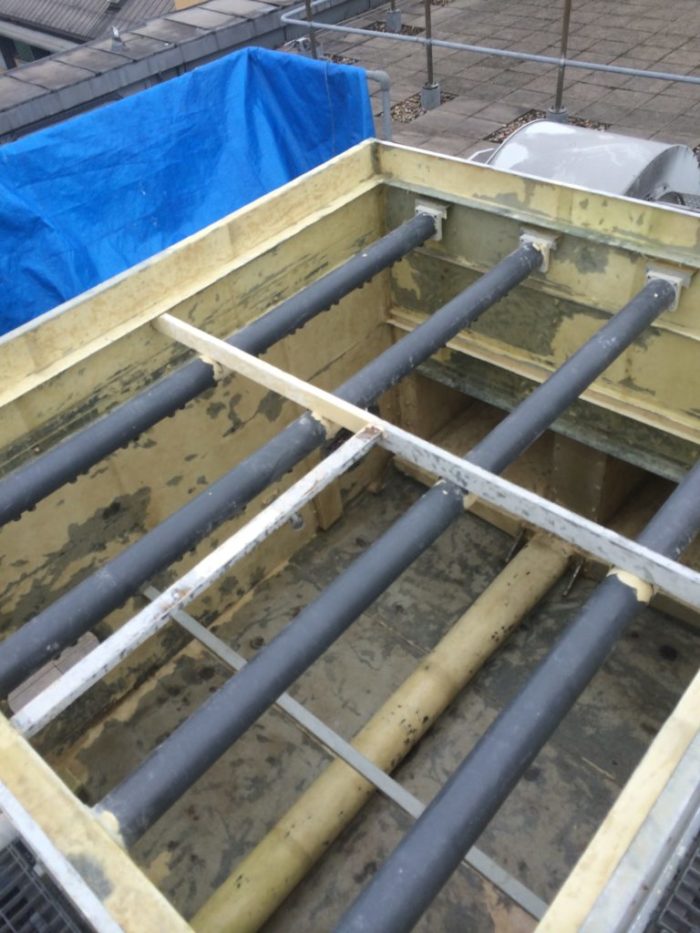
After
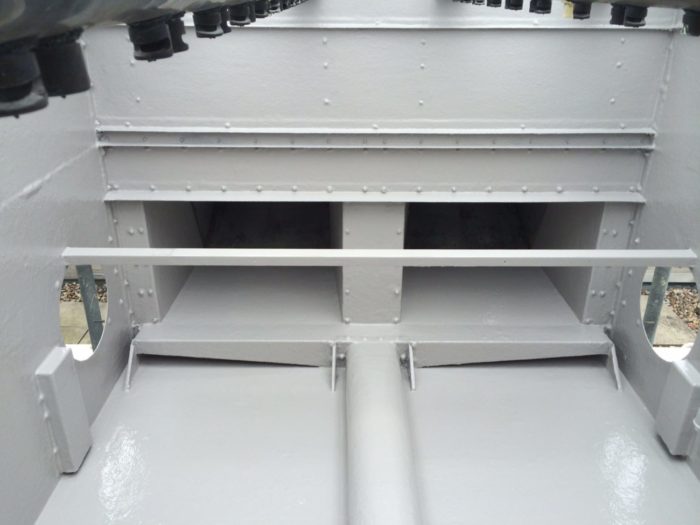
The 5 Stage GRP Lining Process
The below 5 stage process is what Vistech provide as a standard in all of our GRP lining projects.
1. The importance of good preparation – Mechanical or Grit Blast
The underlying qualities and condition of the substrate material being lined will determine the most suitable preparation method. Where the underlying material still has its own inherent structure then high-pressure grit blasting is the most efficient way to prepare the surfaces of the material to be lined. This is typically used on tank walls. This will remove any existing corrosion, scale and process residues.
Where the material is more fragile such as a weak metal structure, or the environment does not lend itself to grit blasting, such as on building tops, then mechanical preparation should be the preferred method. This could include steam cleaning, acetone wiping or wire brushing. Either way, ensuring the material to be lined is suitably prepared is critical to the overall success of the lining solution and should be completed by experienced contractors.
2. Primer Layer – Sealing and providing a bond
Once the area to be lined is suitably prepared a primer layer is applied. The purpose of this is to seal all surfaces and provide the bond between the substrate and the GRP lining.
3. GRP Matting and Resin Layer – providing the strength and flexibility
A fibreglass layer, typically either 450gm or 600gm is applied by hand and fully wetted out with resin. This layer forms the mechanical strength of the lining. The chopped strand fibreglass matting is fully saturated and consolidated with resin and carefully moulded to the internal surfaces. The fibreglass is applied wet upon wet with 50mm overlaps creating a seamless membrane.
4. Resin Wash Layer – ensuring no leaks
A further coat of resin primer is applied to seal the surfaces and seal any pinholes prior to application of the topcoat.
5. WRAS approved Polyester Flow-Coat Finish
This is the top coat which provides an enamel like protection for the GRP lining. The flow-coat surface is smooth and easy to clean and can withstand sudden temperature changes and water treatment chemicals. If, however there is a requirement for slip resistance surfaces a spread of glass beads can be included in the final coat. The grade of bead can be varied to cope with different requirements.
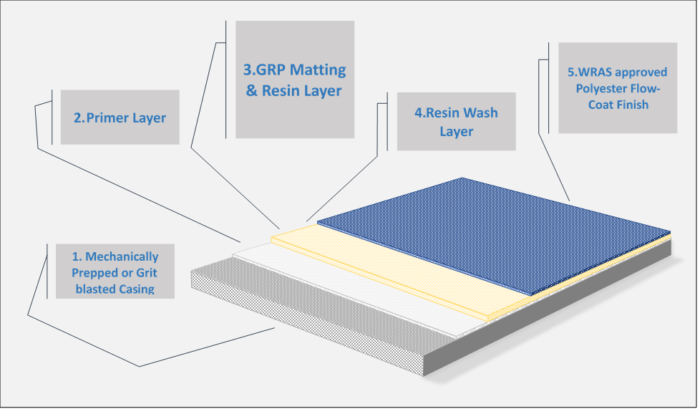
When to install GRP Lining?
Before it’s too late…not to sound sensationalist but allowing tanks, bunds and cooling tower casings to degrade to such an extent where there is very significant corrosion or leaking joints could become costly.
Where leaking tanks exist, the problems can be multiple ranging from the pollution to financial loss through the cost of water and chemicals. The cost of replacement is usually prohibitive, and this is aggravated by the removal of the old, re connection of new and disposal of scrap. The problems being experienced are compounded by the loss of the facility or even total shutdown.
Where corrosion is extensive in tanks to the point where there is significant pitting or visible holes, plates can be fixed to cover the worst affected areas. These can then be coated in GRP to provide a seamless finish.
GRP can significantly extend the life of the existing tanks beyond their conventional life by installing a ‘tank within a tank’. The principle also applies to bunds, gutters, chutes etc.
Alternatives to GRP Lining
There are alternatives to GRP however none provide the versatility and longevity of a quality GRP solution.
The alternatives of GRP linings include tiling, which has its own unique problem areas such as the grout line. Moisture penetration from continual cleaning can cause lifting which produces a space for undesirables to breed. Conventional cladding by its nature leaves its own space which creates its own nesting and breeding ground for germs and rodents. High pressure washing can break seals and allow water to sit behind the cladding which can cause extensive damage.
A GRP tank lining is also thicker than an ordinary epoxy coating. Where the latter is typically only a 0.5mm barrier, a fibreglass tank lining is between 3mm and 4mm thick. GRP lining also performs better with treated water systems as it is formed using high grade materials for improved resistance to bacterial growth, increased water resistance and reduces the risk of osmotic attack.
Table comparing GRP lining versus other coatings and containment systems
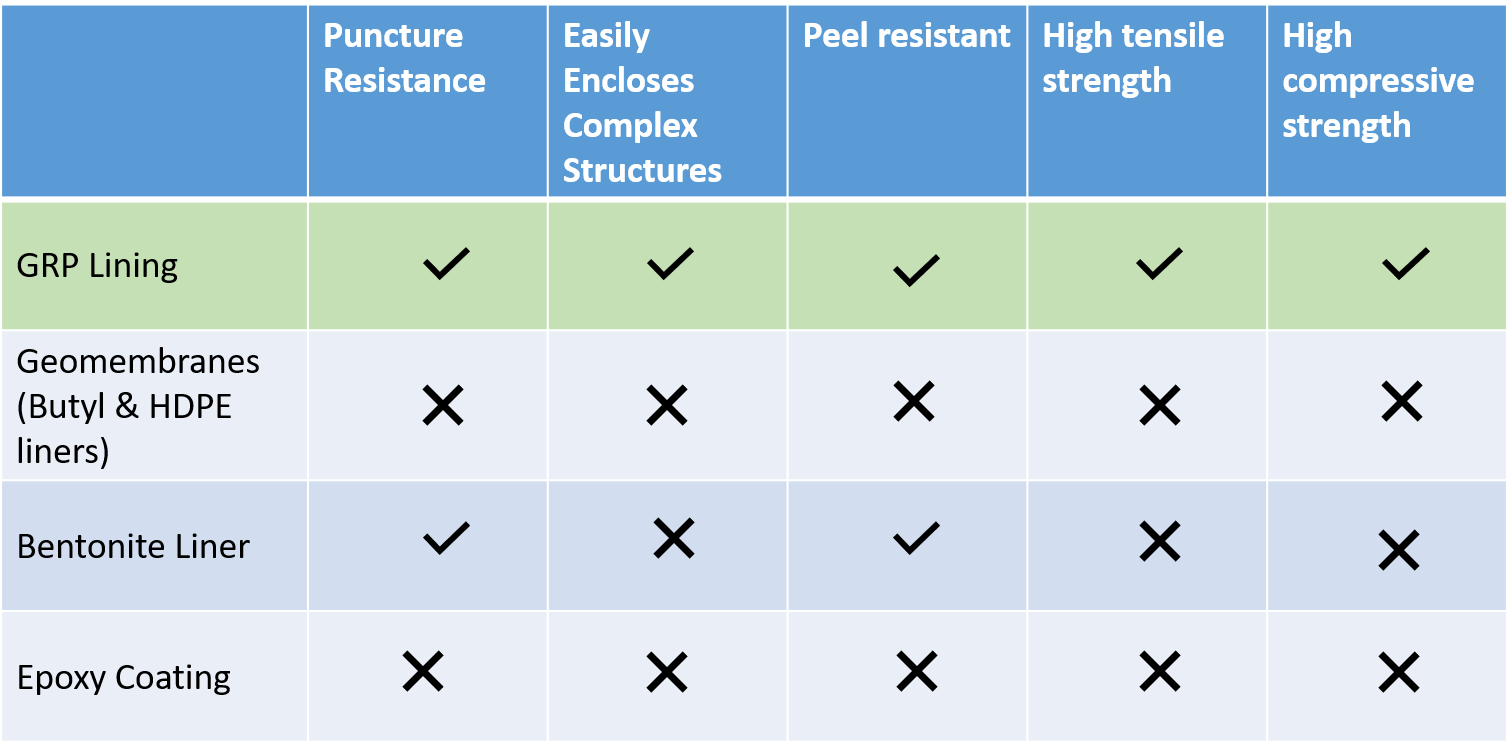
Other considerations
When considering your tank, bund, cooling tower etc. refurbishment projects then GRP lining should be a serious contender. Where other coatings may provide a superficial ‘fix’ for a limited period, a GRP lining solution will give you peace of mind that you have extended the conventional working life of your plant for years to come.
It’s also important to understand when not to use GRP as a solution however this really is only in the worse case scenarios where the underlying material has lost all integrity. In situations where this is a potential a site survey is a must. It may be the case that the tank requires replacement.
Can your business afford the shut down period? A typical lining project takes 4-5 days to complete. Of course, replacement of tanks can be disruptive, but it may be possible to swap out in a shorter time than lining. The costs will be higher to replace a tank, but this might be the only suitable option available.
Can we help you?
If you are considering GRP lining any of your existing tanks, bunds, cooling towers and have any questions or would like to arrange a free site survey, then please call our technical sales team on 01403 892 622 for a short 10-minute consultation or email me at richard.crunden@vistechcooling.co.uk If you quote this article when calling, we will offer you a 5% discount on any GRP lining work that we complete for you. Vistech Industrial Services have extensive experience of providing quality linings for our clients with 5 and 10-year guarantees.

Lucy keeps the well oiled machine of Vistech Cooling running smoothly. She has close to a decade of experience working in the industry and creates industry-leading content that provides necessary information but also deeper insights into the field most people may not have considered.
